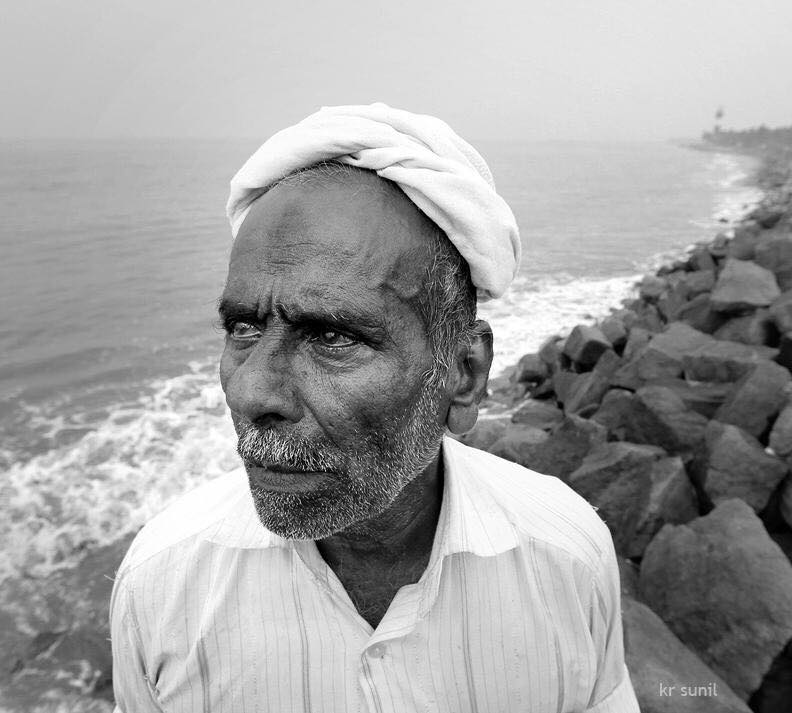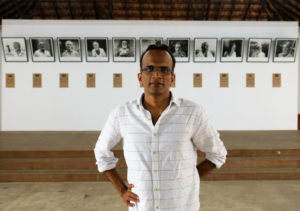Much has been written about how the Malabar Coast connected Kerala with the rest of the world. The commercial activity in this region brought in not just material exchanges from across the globe, but also forms of belief, culture, tradition, and religion. K.R. Sunil’s exhibition, ‘Manchukkar: The Seafarers of Malabar’, tells the stories of arguably the last links in this chain.
S. Harikrishnan

Self-narratives are special. They often throw light on what historians don’t. It is through the fabric of the everyday that such narratives are woven, revealing astonishing tales about people, their lives and their times. K.R. Sunil’s photo exhibition on the seafarers of 20th century Malabar—manchukkar/മഞ്ചുക്കാര്—recovers such narratives. A manchu or dhow (also called pathemari or vanchi) is a wooden boat that the seafarers of Malabar used for travel and trade. Before motors became common in the second half of the 20th century, dhows sailed on winds, their masts often standing as tall as fifty feet. In a collection of black-and-white portraits, Sunil absorbs the lives of the sailors—their hopes, dreams, and memories of a time at sea. All of Sunil’s subjects are men, now over sixty years of age, who joined the boats in their teens as cooks. Those who stayed on became deckhands and captains. Some went on to serve for as long as half a century.
About those long years at sea, some recollect heartwarming tales of friendship and camaraderie. Sixty-four-year-old Hussain has fond memories of making friends and exchanging gifts with Arabs on his travels to Ajman and Muscat. The boats often carried clothes and other accessories that labourers in Arab countries sent back home to Kerala. For many in the villages of Malabar, these manchus were their ticket to big cities like Kozhikode and Bombay or to the Arab lands. Abdullakutty, sixty-six, recollects a fascinating ‘ceremony’ for new sailors before they saw the skyline of Bombay for the first time: ‘You must wash your eyes with turmeric water before you look at the big city!’

But for the most part, life at sea was far from easy. ‘Death was a constant companion’, recollects seventy-year-old Kunjava about a boat-wreck that almost killed him. Kunjamu (67) remembers being crammed on a small life-boat with his crew after a storm swallowed their dhow. Everyone tied themselves to each other so that at least their bodies would be found if they all died. Some, like Manchukkoran of Kasaragode, hung their boots early because of near-death experiences at sea. The cyclone from 1967 seems etched in the memories of many of these sailors. Two boats from Ponnani—Duldul and Vijayamala—were destroyed by this cyclone, and many lives were lost. Ummar Srank, now in his seventies, was among the lucky ones who survived. His wife remembers being terrified because news of the deaths of her neighbours at sea reached home before Ummar could return. During the Indo-Pakistan War (in 1965), some of the sailors at sea spent their days in constant fear of being bombed. P. Ummar and his crew had to live on the boat at sea in total darkness for a week because they were given strict instructions to have their lights turned off after dark. Some also recount disturbing tales of sexual abuse by the captains.

Sunil first met the seafarers while working on his project on the history of Ponnani (part of the 2016 edition of the Kochi-Muziris Biennale). This exhibition on the sailors adds to Sunil’s excellent documentation of everyday life in Malabar and its ‘histories from below’—histories of the less powerful that often remain undocumented. When asked why he chooses to do portraits, he quips: ‘It is people’s stories that brought me to it…it’s not just about taking pictures. These people have a history that needs to be told’. He plans to extend this work into a book, complete with more pictures, artefacts and stories.
Through Sunil’s evocative photographs, we get a glimpse of a powerful and moving world of hardship, pain, sacrifices, friendships and love. On land, it was often poverty and hunger that forced these young boys to take up these dangerous voyages. At sea, cyclones and storms were constant companions, often wreaking havoc and loss of life. Between these, on boats to far-off lands, the seafarers sailed towards hope.
(Sunil’s exhibition ‘Manchukkar: The Seafarers of Malabar’, is on exhibit till March 31, 2019, at Uru Art Harbour, Mattancherry, Kochi)
About the Author: S. Harikrishnan is a doctoral research student at Dublin City University, and a co-editor of Ala. He can be contacted at [email protected].

Very interested to learn about the books you people are reading. I have in New York a large
collection of old books dealing with the Malabar Coast … am looking for a New York based library that wants such books. I have left my email address and really would love to hear from you all. Anhyone studying about Kerala past or present let me know. I first went to Kerala to work in 1958.